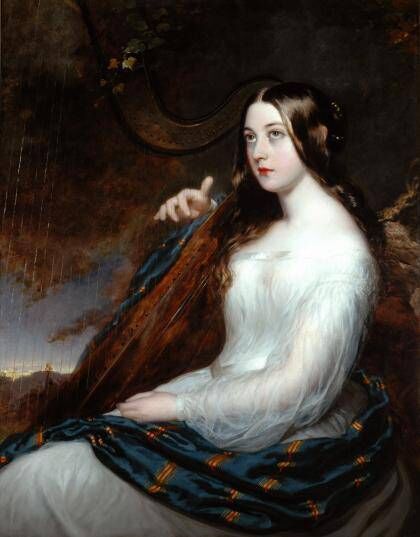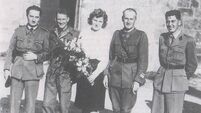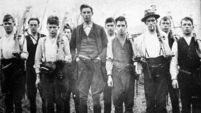Clodagh Finn: The toe-curling poem that led to the rediscovery of Sarah Curran

Trish Sissons, a Dublin-based Canadian writer is inviting people to read their “cringiest diaries/poems/song lyrics/chat logs/Tumblr feeds” in 'Angst from the Archive' on November 6.
I’m very sorry I didn’t keep it, the cringe-making poem I once wrote that told the story of the doomed Irish Rebellion of 1798 in sing-songy verse.
One of the couplets — although that is far too grand a name for it — rhymed ‘schooner’ with ‘sooner’. Something along the lines of: “They sent all the way to France for a schooner/ It was such a pity it didn’t come sooner.”
I was 12 after all and, even then, I knew that “French naval expeditionary force” was lyrical suicide, even if it did offer a tempting range of rhyming possibilities (course, source and, with a bit of posh diction, endorse and remorse).
The poem moved on to the later rebellion of 1803 and the unbearably sad story of its executed leader Robert Emmet and his bereft fiancée Sarah Curran; the whole endeavour prompted by Miss O’Dowd, a brilliant teacher who lit the fire of creativity in 5th and 6th class in Presentation School in Tralee so many years ago.
I wish I had it still so that I might offer to read it at the upcoming ‘ ’, a fantastic idea from Dublin-based Canadian writer Trish Sissons who is inviting people to read the best of their worst teenage poetry, journals, song lyrics and any other woeful scribblings lurking on hard drives or in dusty folders.
HISTORY HUB
If you are interested in this article then no doubt you will enjoy exploring the various history collections and content in our history hub. Check it out HERE and happy reading
The curated show, which opens at 7pm at the Tara Building in Dublin on Thursday, is a celebration of the universality of teenage embarrassment. Better still perhaps, it encourages the very healthy pursuit of laughing — maybe crying a little too — at our younger selves and not taking any of it too seriously.
“The only rule is that the readers can’t be proud of [their previous work],” says Sissons, an organiser willing to put her own mortifying lines where her mouth is, so to speak.
And here’s the proof of it: “One of my gems from when I was 13 features the line, “trust the you that you don’t know / you’re not being sensually sensual”, which is both wild for a 13-year-old to write and horrifying to say aloud to a room of people. The distance in time is the only thing that makes it manageable.”
I have to admit, I’d be proud of that 13-year-old, just as I am proud of the pre-teen would-be poet who tried to capture a little bit of history in painful rhyme.
The instinct to write is deep within so many of us, a fact that doesn’t get enough recognition, I think. Allowing people to stand up and laugh at themselves is not only comedic gold but a wonderful way of opening up the writing valve and letting whatever is inside sputter out.
And it does sputter at first. Remember that phase when you discovered the thesaurus along with the beginnings of your own voice?
Sissons asks the question and, unbidden, that essay which had both ‘deleterious’ (no, I’m not sure what it means either) and ‘indubitably’ (we were reading Jane Austen) on the same page jolts back into my horrified mind.
But then, it takes a while to know what your own voice sounds like. And just when you think you’ve pinned it down, it changes again because writing is, in essence, rewriting.
If you’re like me, you will never quite be satisfied that the words you’ve committed to the page reflect the idea in your head. The inside never matches the outside, but the thrill of writing is to keep trying.
I’m glad the memory of that early ‘poem’ resurfaced for another reason; it gives me a chance to remind people that its subject Sarah Curran was a real poet. It is still shamefully little known that she was part of an important literary circle of women when she lived in Cork City from 1803 to 1805.
She moved to the city after Robert Emmet’s execution but, for so long, the story of her life was framed in relation to the men in her life. She was the heartbroken fiancée thrown out of her family home by a father, John Philpot Curran, worried that his daughter’s relationship would damage his own legal business.
But when she took refuge in the county of her birth (she was born in Newmarket in 1782) and moved in to the home of philanthropist Cooper Penrose of Woodhill, Cork, her creative side flourished.
That is how she came to deepen her friendship with Penrose’s daughters, Anne and Bess, and join a Cork-based literary network with significant international connections.
Historian Angela Byrne wrote the women’s overlooked contributions back into being in an eye-opening article published in 2023 in the . It should be required reading because it establishes Sarah Curran as a historical figure in her own right.

She was a poet, a harpist, a vocalist and a person of great creative force whose work was treasured in a women’s literary circle that revolved around the Wilmot, Chetwood and Penrose families in Glanmire.
The literary output from this little-studied circle was formidable, writes Byrne. Here’s a small taste of it: “In aggregate, the group composed hundreds of poems, elegies and ballads, most of which remain unpublished; two anonymous novels ( , 1827 and , 1829); and thousands of pages of journals and correspondence… including diaries and letters of long residences and travels in France, Italy, Russia, and Vienna.”
The group also included such luminaries as the Cork-based Wilmot sisters. Martha Wilmot edited and translated the memoirs of Princess Dashkova, a Russian noble woman and one-time confidante of Catherine the Great while her sister Katherine was a traveller and diarist who rubbed shoulders with Napoleon during her travels around Europe.
Sarah Curran was at the heart of this network and when she moved to Sicily after marrying Captain Robert Henry Sturgeon in November 1805, she maintained her links to Cork.
There, she embroidered a map of Ireland in coloured threads on a piece of satin (now in the National Library of Ireland) and rediscovered her love of drawing. She wrote: “I have often had an idea of drawing a little general sketch of the parlour at Woodhill as we used to be in some of those blessed days, some working and at the harp, etc.”
What I wouldn’t give to have been a fly on the wall during those “blessed days”, earwigging on a group of intelligent, well-travelled and endlessly curious women having the chats in the well-appointed drawing rooms of Glanmire.
Sarah Curran had accomplished herself in music, writing and art but she also wanted to broaden her skills to include “Mathematicks (for the sake of clearing my brain)” and add French to the Italian she learned when she moved to Italy.
She was delighted to discover she was pregnant in 1807 but had to face the unspeakable difficulty of losing her son days after he was born during a storm at sea in January 1808. Sarah herself died months later, aged just 26, on May 3, 1808.
Little wonder that her memory has been characterised by heartbreak and tragedy. But that is not the whole story.
In recent years, her creative contribution — so much in such a short time — has been carefully reconstituted by Angela Byrne and other academics. It is also wonderful to see it celebrated by fellow Newmarket woman Katherine Walshe whose fascinating 2022 study traces her life in the round in an illustrated map (), complete with music and countless references.
To return to the present, I wonder what Sarah Curran and her writing circle would make of next week’s . I can’t help thinking that anything which unites people in the name of writing and friendship would win their approval.












